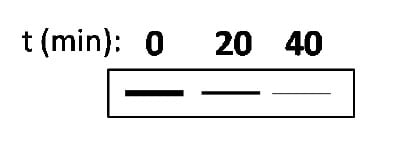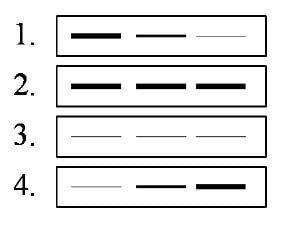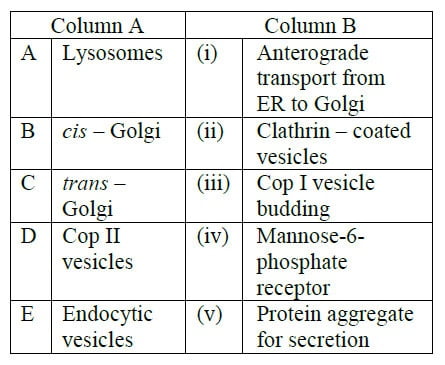Dear Students,
Welcome to Molecular Biology MCQ-15 (Molecular Biology CSIR NET Questions). This MCQ set consists of Advanced (Post Graduate Level) Molecular Biology Multiple Choice Questions with Answer Key. All these questions were taken from the previous year question papers of CSIR JRF NET Life Sciences Examination. These questions can be used for the preparation of Competitive examinations in Biology / Life Sciences such as CSIR JRF NET, ICMR JRF, DBT BET JRF, GATE and other University Ph.D Entrance Examinations. After marking your answers, please click ‘SUBMIT‘ button to see your ‘SCORE‘ and ‘CORRECT ANSWERS‘.
You may also like: Molecular Biology Notes | Molecular Biology PPT
(1). A researcher is studying the subcellular localization of a particular protein ‘X’ in an animal cell. The researcher performs successive centrifugation at increasing rotor speed. The researcher starts spinning the cellular homogenate at 600g for 10 min, collects the pellet, spins the supernatant at 10,000 g for 20 min, collects the pellet, spins the supernatant at 100,000g for 1 hour, and collects both the pellet and the final supernatant. On subjecting various pellets and the final supernatant to Western blotting with anti-protein-X antibody, the protein X is observed to be maximally expressed in pellet after centrifugation at 10,000 g. Based on the above observation, what will be the most likely localization of protein X. (CSIR_2015_II)
(a). Nucleus
(b). Ribosomes
(c). Mitochondria
(d). Microsomes
(2). Error-free repair of double strand breaks in DNA is accomplished by: (CSIR_2016_I)
(a). Non-homologous end-joining.
(b). Base excision repair.
(c). Homologous recombination.
(d). Mismatch repair.
(3). RNA interference is mediated by both siRNA and miRNA. Which one of the following statement about them is NOT true? (CSIR_2016_I)
(a). Both siRNA and miRNA are processed by DICER.
(b). Both siRNA and miRNA usually guide silencing of the same genetic loci from which they originate.
(c). miRNA is a natural molecule while siRNA is either natural or a synthetic one.
(d). miRNA, but not siRNA is processed by Drosha.
(4). Which one of the following best defines an oncogene? (CSIR_2016_I)
(a). An oncogene never codes for a cell cycle protein, which promotes cell proliferation.
(b). Oncogenes are always involved in inherited forms of cancer.
(c). An oncogene codes for a protein that prevents a cell from undergoing apoptosis.
(d). An oncogene is a dominantly expressed mutated gene that renders a cell advantageous towards survival.
(5). Insulin increases facilitated diffusion of glucose in muscle cells by:- (CSIR_2016_I)
(a). Phosphorylation of glucose transporters.
(b). Translocation of glucose transporter- containing endosomes into the cellत membrane.
(c). Inhibition of the synthesis of mRNA for glucose transporters.
(d). Dephosphorylation of glucose transporters.
(6). Some errors occur during DNA replication that is not corrected by proof reading activity of DNA polymerase. These are corrected by specialized repair pathways. Defect in the activities of some of the following enzymes impair this process. (CSIR_2016_I)
(A). DNA polymerase III and DNA ligase
(B). AP endonuclease and DNA glycosidase
(C). Mut S and Mut L
(D). Rec A and Rec F
Defect in which of the above enzymes impair the process?
(a). A, B, and C
(b). D and B
(c). A and D
(d). A and C
(7). A eukaryotic cell undergoing mRNA synthesis and processing was incubated with 32P labelled ATP, with the label at the β-position. Where do you think the radioactive isotope will appear in the mature mRNA? (CSIR_2016_I)
(a). 32P will not appear in the mature mRNA under any circumstances because β and γ phosphates are released during transcription.
(b). Phosphate groups of the phoshodiester backbone of the mRNA will be uniformly labelled as only α phosphates are released during transcription.
(c). 32P will appear at the 5′ end of the mRNA if only it has “A” as the first nucleotide.
(d). No 32P will appear in the mature mRNA because the 5′-terminal phosphate of an “A” residue will be further removed during the capping process.
(8). One of the cellular events that TOR, a kinase, positively regulates is the rate of rRNA synthesis. TOR regulates the association of a transcription factor to a Pol I subunit. When TOR is inhibited by the drug rapamycin, the transcription factor dissociates from Pol I. A yeast strain is engineered, which expresses a fusion of the transcription factor and the Pol I subunit. The level of rRNA synthesis is monitored in these cells using pulse labelling following rapamycin addition for the times indicated below. The transcript profile of rRNA observed for the wild type cells is given below:

Identify the pattern expected in the engineered strain. (CSIR_2016_I)

(a). Diagram 1
(b). Diagram 2
(c). Diagram 3
(d). Diagram 4
(9). To understand the microtubule-dependent motor activity of a freshly purified motor protein from budding yeast, a researcher set up microtubule based gliding assay. In such an assay where microtubules are fluorescently tagged at its (+) end, the researcher observed that this motor protein moves the microtubule in the direction of its (+) end as shown below:

The newly identified motor protein is: (CSIR_2017_II)
(a). Dynein
(b). Myosin
(c). Kinesin 1
(d). Either Dynein or Kinesin 1
(10). Given below are organelles (column A) and properties associated with the organelles (column B).

Choose the option that matches the organelles with the most appropriate property. (CSIR_2017_II)
(a). A – (iv) ; B – (iii); C – (v); D – (i); E – (ii)
(b). A – (v) ; B – (iv); C – (i); D – (v); E – (ii)
(c). A – (iii) ; B – (v); C – (i); D – (iv); E – (ii)
(d). A – (iv) ; B – (v); C – (ii); D – (i); E – (iii)
